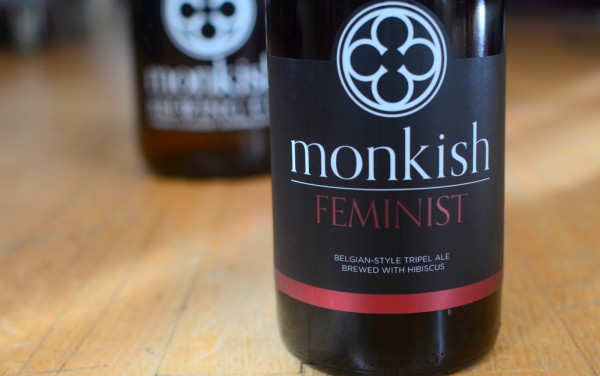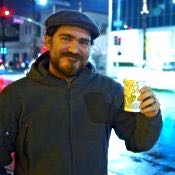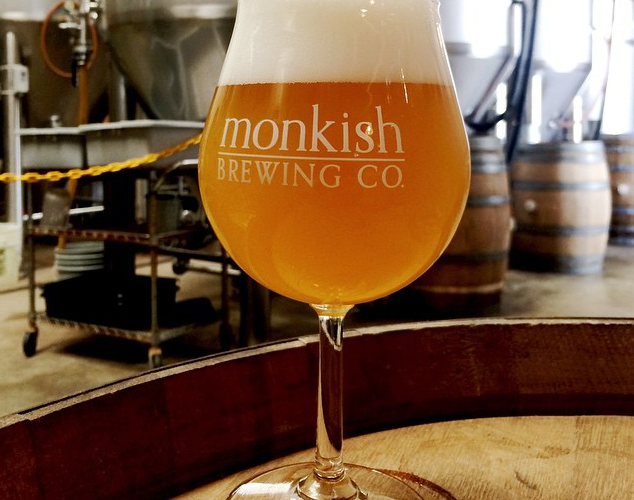Tucked away in an industrial park in the South Bay region of Los Angeles, Monkish Brewing Company has developed a distinct identity and thirsty following in just three years. It’s an identity that founder and brewer Henry Nguyen obsesses over, and Monkish is on the cusp of a dramatic shift in focus and production that will further distinguish the young brewery in the thriving Los Angeles craft beer scene.
While Nguyen has produced a litany of flavorful creations based on Belgian styles and brewing traditions, a mysterious force has slowly infiltrated the wood and the stainless steel of his brewery, a force that is changing the very identity of the young brand.
Bringing Sour Beer to L.A.
What began as an experimentation with the Brettanomyces yeast in a delicate dry-hopped saison (2014’s sublime Selah) has progressed into a collection of yeast and bacteria that Nguyen has fostered in oak foeders, reclaimed puncheons and a portable winemaking tank labeled “the funk box.” He knows there will be no escape from these pernicious organisms once they’ve colonized the brewery, but this spreading accretion of wild yeasts and bacteria is all a part of his plan.
“I always wanted to do all sours, that’s what [my wife] Adriana and I primarily drink, but we didn’t think it would work,” said Nguyen.
He explains that in 2011 in Los Angeles there wasn’t much of a market for sour beers. The craft beer revolution had barely reached L.A. in those days, but Nguyen knew that as craft took hold, the demand for the often polarizing sour beers would grow. He wanted to grow with it.
“The first year we didn’t have the money to buy barrels so we brewed all Belgian beers—it’s what we knew,” said Nguyen. “The goal was just to survive.”
Monkish is a family affair. Nguyen’s wife—Adriana, his high school sweetheart—is a full-time accountant who pitches in at the tasting room whenever she’s off work, and his kids get tutored in math among the oak vessels stacked in brewery’s expanding cellar area.
“I’m the artist, said Nguyen. “Adriana is more the business person. So there is always this tension between making beer and making money. I don’t care about making money, but I’ve got three kids so I have to be careful. I’m happy [making] 1,000 barrels a year.”
Marine Turned PhD Turned Craft Brewer
Nguyen took a long path to opening a brewery. A native of Los Angeles, Nguyen grew up in Gardena—a community known for ethnic diversity (and some of the best Japanese food in the city). He’s cagey about his childhood, alluding to the unspecified mischiefs of youth and a tension between the Vietnamese culture of his parents and his desire for assimilation and conformity. A stint in the Marine Corps provided more than enough of the latter, and he followed his service with an immersion into academia that culminated in a PhD in the New Testament from the University of Aberdeen in Scotland. It was during his family’s time in Scotland that Nguyen discovered a love for beer, and homebrewing soon became a creative outlet to help him cope with the rigors of making ends meet publishing and lecturing in a grim economy.
When Monkish opened its doors in 2012 there was only a pair of other breweries operating in Torrance. The South Bay is now home to nine craft operations, and Nguyen has strived to create a distinct identity for his brewery. His vow to never brew an IPA began as a tongue-in-cheek proclamation of his desire to not conform with what’s become standard operating procedure for new craft breweries. Though, he admits that eschewing the ever-popular pale ales and IPAs has made establishing the brewery, and the cash flow needed to operated it, difficult.
“It’s about being focused,” Nguyen said with a tinge of weariness. “I like the idea of focus and a clear identity in everything. Being unique doesn’t pay the bills.”
Balance and Subtlety
 Early on, it was a deft application of uncommon brewing ingredients that helped Monkish find their place in the expanding Los Angeles craft beer scene. Nguyen developed a reputation for infusing brews with flavors from his Asian-American upbringing. The impetuous brewer has utilized everything from the relatively pedestrian (hibiscus flowers featured in several brews, including the flagship Feminist tripel) to the downright avant garde like Szechuan peppercorns that provide a curious piquancy to the rich and fruity dubbel Shaolin Kick.
Early on, it was a deft application of uncommon brewing ingredients that helped Monkish find their place in the expanding Los Angeles craft beer scene. Nguyen developed a reputation for infusing brews with flavors from his Asian-American upbringing. The impetuous brewer has utilized everything from the relatively pedestrian (hibiscus flowers featured in several brews, including the flagship Feminist tripel) to the downright avant garde like Szechuan peppercorns that provide a curious piquancy to the rich and fruity dubbel Shaolin Kick.
While it may be tempting to dismiss such unconventional additives as gimmicky, Nguyen’s soft touch with the spices and herbs means that they’re never the star of the show. Somehow he always manages to strike a perfect balance with the subtle use of culinary flavors and the esthery punch of the Belgian yeasts.
Three years into the brewery and Nguyen hasn’t gotten a lot of sleep, but he has built an impressive book of recipes that showcase dramatic yeasts, unexpected flavors of herbs and spices and the unique aromas of new hop varieties. He’s even stepped back (slightly) from his promise to never brew an IPA, and changed his relationship with hops. He now approaches Humulus lupulus as he would any of the other pungent botanicals that he’s used to flavor his brews.
“When we opened, we really didn’t know much [about hops],” Nguyen said. “This year we got contracts for all the sexy hops, and we are experimenting with them to discover how they work with different styles, with bacteria, [and] in brett beers.”
Examples of these hop-driven exercises like Altar Boy (a single-hop pale ale showcasing funky-tropical Mosaic hops) or Galaxy Defender (a blonde ale with grapefruit peel and the eponymous Galaxy hops) underline Nguyen’s skill in coaxing compelling flavors from botanicals. A skill, he says, is based in a near obsession with detail.
This obsession with details has defined Nguyen’s life, and he says the Marine Corps taught him how to harness that neurosis. He is now mindful of the pull that his obsessions can have on his focus and energy and he uses it to drive him. His current fixation has driven him deep into the microscopic world of Brettanomyces, Lactobacillus and Pediococcus.
Focus on Alternative Fermentation
He’s amassed a collection of dozens of used wine barrels and a puncheon (a large wooden barrel over twice the size of a standard wine barrel), as well as four 30-year-old foeders (giant oak tanks) from a Napa winery, and a stainless koelschip the size of a small hot tub.
He is all-in on alternative fermentation and has compiled over a dozen strains of Brettanomyces and bacteria, including attempts to isolate local strains unique to L.A., and he strives to replicate as many brewing conditions from his Belgian inspirations as possible.
“I track the weather in L.A. and Belgium, and try to find the best time to brew and ferment these beers,” Nguyen said. He’s even stopped using a spreadsheet to track a beer’s progress from brewday through aging. Instead, the Monkish brewing team clips handwritten notes to the barrel. “I want the brewers to have a personal connection to every barrel,” and he says this connection means a better understanding of how the microbes affect the developing beer.
While Monkish has yet to fully debut these alternative fermentation brews, the next chapter in the history of the this distinctive brewery has already begun. There’s no turning back once the wild organisms seep into the crevices of the brewery, but Nguyen has faith that the best Monkish beers haven’t yet been brewed.
“We’re always trying to make the next glass of beer better than the last one.”
 John Verive (@octopushat) is the founder of Beer of Tomorrow, freelance writer, editor of Beer Paper LA, contributor to LA Times Food, Certified Cicerone®, optimist and proud Angeleno.
John Verive (@octopushat) is the founder of Beer of Tomorrow, freelance writer, editor of Beer Paper LA, contributor to LA Times Food, Certified Cicerone®, optimist and proud Angeleno.
CraftBeer.com is fully dedicated to small and independent U.S. breweries. We are published by the Brewers Association, the not-for-profit trade group dedicated to promoting and protecting America’s small and independent craft brewers. Stories and opinions shared on CraftBeer.com do not imply endorsement by or positions taken by the Brewers Association or its members.

Share Post